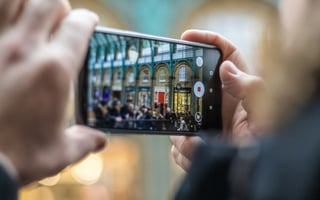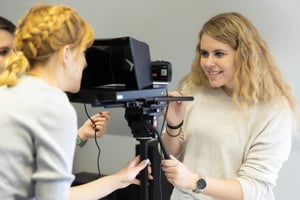We are increasingly asked about the role of video in crisis communication. Can it help you control...
It has never been easier to make video.
Almost everything you need is right there in your pocket.
But not all video recorded on smartphones is good quality. And we often see the same mistakes that prevent footage from being watched by the intended audience.
The good news is these errors can be avoided with a bit of know-how and training. And that way, everyone can make professional-looking videos on their phones, whether they are for social media feeds, websites or internal staff briefings.
Here are the five most common smartphone video errors our tutors see and the steps you can take to avoid them.
Sound barrier
You might think visuals are the crucial component of video.
But according to Anna Brees, the expert tutor on our online smartphone video training, good quality audio is the most vital part.
And the issue with that is while smartphones have built-in microphones, they are low quality.
To put that into context, you can’t be more than 3ft from the person you are interviewing if you are going to get decent sound. And you’ll need to film somewhere particularly quiet because the phone mic will pick up all the background noise.
If that doesn’t work with your filming plans, you will need to invest in microphones.
You can get a good lapel microphone that you insert into your device for as little as £15.
Wireless ones are also available, but there is often a nagging doubt that it is not connecting properly unless you invest in really decent kit, which will start to cost you.
Poor lighting
You don’t necessarily need expensive equipment, but you do need to pay attention to the lighting in your videos.
Grainy, low-quality footage will put people off from watching your videos.
You need to film in brightly lit locations and ensure the light is on your subject.
As we say during our on-demand smartphone video training course, it is all about ‘bum to the sun’.
That is a simple way of remembering that when you are filming, the sun or light is behind you and is shining on the person you are filming.
If you are doing a piece to camera (media jargon for when you talk directly to the audience), you need to ensure the light is on you.
Unless you want to lug around lots of kit, it is best to keep it simple and rely on natural light. But if you are filming somewhere dark, you will need to consider investing in an artificial light source you can plug into the wall.
I always thought video was out of reach for me as I have a moderate marketing budget. The course made me realise how much I can do myself now that I understand the basics and understand how to use the Kinemaster app to apply professional editing techniques. I really enjoyed the online modules as I could do them at my own pace and fit them around my work commitments. The follow up session with Anna was great to get some feedback, build my confidence and reinforce all the learning.
— Karen Blackmore, Marketing Communications Manager for TP Group
Unstable
Mobiles are light, and it can be challenging to keep them steady when filming.
And this can result in shaky footage that may leave your audience feeling seasick – not something likely to keep them watching.
There are a few ways you can prevent this problem. And again, you don’t necessarily need to invest in expensive equipment.
The simplest – and cheapest – way to ensure stability is to get into the habit of tucking your elbows into your sides when you film with the camera held out in front of you.
If you think some equipment may be beneficial, you may only need a simple selfie stick to get that stabilization.
If you want to go further and invest in a tripod, go for one at least 50 inches tall. It will give you plenty of scope to adjust the height when you carry out interviews.
The added benefit of using a tripod is it frees up your hands to add impact for those pieces to camera.
No subtitles
This could sound odd after we made a big point about the value of good audio, but many people watch videos in silence.
In fact, according to multiple reports, 85 per cent of the 8 billion videos viewed on Facebook are watched without audio.
Now, the figures vary between the different platforms, with a similarly well-circulated statistic showing 96 per cent of videos on YouTube being watched with audio.
But what is clear is that muted volume is a popular option.
So, subtitles are crucial. Not only do they help you reach those social media users who don't have the sound on. But they also ensure all those with hearing difficulties or who don’t speak English as a first language are not excluded.
And that’s not all.
Researchers have also found that audiences are more engaged in videos with subtitles, with 91 per cent of videos with subtitles being watched to completion compared to 66 per cent of those without.
And a report by Verizon Media in 2019 found that when captions are available, 37 per cent of viewers said they are encouraged to turn the sound on because the videos seem more interesting.
As Anna explains during our smartphone video training course, there are some affordable and easy to use apps that make adding subtitles a lot less daunting than it may seem.
I’ve just completed the online course which explained how to film and edit my own videos. It was a really engaging course with lots of new information in it, like the most important things to consider when setting up a shot. Also the apps that I can download to use for filming, editing, and for autocue. I’m feeling more confident now, especially about knowing how to engage with the audience.
— Zoe Fudge-Ajadi, Project Manager & Trainer, deafPLUS
Bad framing
We have been treated to some strange camera angles over the past year or so, thanks to the world’s homeworking experiment and endless zoom meetings.
And, to some extent, we have been pretty forgiving of them as we all adjusted to new ways of working.
But people are less tolerant of dodgy angles when it comes to the videos we choose to watch.
No one wants to see the top of someone’s head and a big chunk of sky or to be looking up somebody’s nose. It looks amateurish.
You want the eyes of your audience to be firmly fixed and drawn to whatever is the focus of your piece. Your viewers want to feel as though your subject is talking to them directly. And that means you need to get the framing right.
The key is to make sure that the camera is at eye level and that the person you are talking to maintains good eye-contact.
Keen to find out more about using smartphone video in your comms strategy?
Our online course not only shows you how to capture and edit footage, but we also explain what makes video content stand out and the publishing tips to ensure it receives more views. It also includes examples of the additional kit mentioned in this blog that you may need. And, at just £195 + vat for a single-user licence, and only £595 + vat when you buy a team licence for up to six delegates it represents excellent value for money.
Media First are media and communications training specialists with over 35 years of experience. We have a team of trainers, each with decades of experience working as journalists, presenters, communications coaches and media trainers.
Subscribe here to be among the first to receive our blog.




